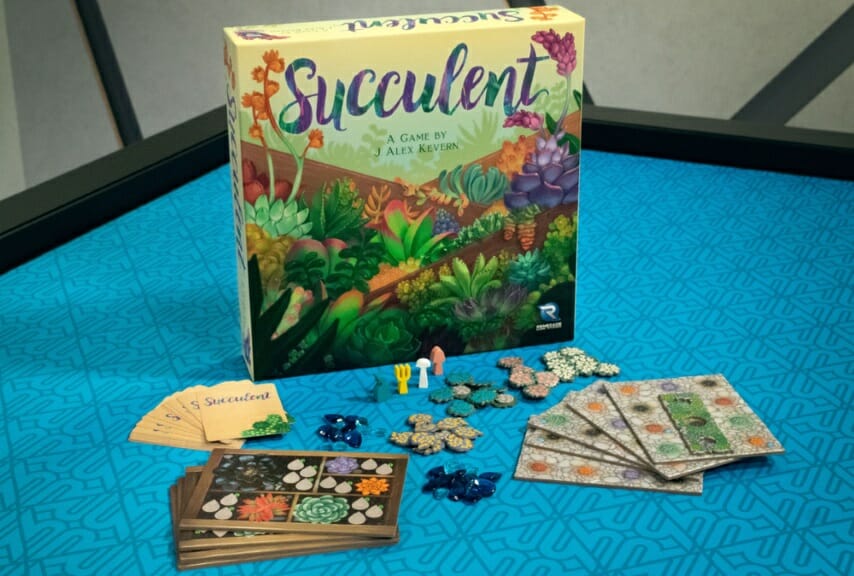Succulent is a fun new tile-laying and set collection game that plays quickly and doesn’t have that many rules to learn, giving you a choice of one of two actions on every turn, plus the chance to turn in the tokens you’ve collected if you meet an objective. It’s a bit held back by some of the art and graphic design choices, unfortunately, although that’s something Renegade should remedy in future editions.
In Succulent, players will compete to place their own garden tiles on a modular central board that comprises tiles with 3×4 grids showing plants in five different colors. When you cover those plants with your tiles, you get ‘cuttings’ in those colors, and over the course of the game you’ll gather those cuttings in sets to match those shown on the five or six public objective cards, gaining victory points and sometimes additional bonuses like free cuttings.
There are also water droplets shown on three of the 12 plants on each piece of the central board. If you place your garden tile over one of those plants, you get a small water droplet and can place it on any open space on your personal player board, which has areas for all five types of cuttings. Once you’ve filled the droplet spaces (from two to four) in a specific plant’s area, you can trade them in for a cutting of that color when fulfilling an objective card.

You only start the game with two garden tiles, one of which covers a single plant and one of which covers two, and to get others you must take your player token and place it on the bottom right corner of one of the open objective cards, which gets you the garden tiles shown at the bottom of that card. If anyone, you included, completes that objective, you get a large droplet, which goes on your personal player board and never comes off. Several spaces on that board give you one to three points at game-end if you have large droplets on them, but nothing if you have small droplets (those are worth ½ point each). Those two mechanics feel a bit disconnected; you aren’t actually claiming the card on which you placed your personal token, and getting that large droplet is kind of out of your control.
Turns in Succulent move quickly, because each player takes a single action—either you place a garden tile, or you place your token on a new card to get more garden tiles—and then, if possible, trades in cuttings to fulfill one objective card. There are no rounds, so play is continuous, and the game ends when one player finishes a set number of objective cards that’s tied to the player count.
There are some visual design issues within the game that I’d like to see resolved in future printings. The colors of the brown cuttings and symbols on cards don’t match the nearly black flowers shown on player boards. Some of the iconography on the cards isn’t all that clear; some objectives give you a bonus one-space garden tile when you complete, while others let you place a one-space garden tile as long as you already have one. The grey backgrounds on the central board tiles don’t provide that much contrast with the cuttings, and I’m pretty sure the whole thing is unplayable if you’re color-blind since the cuttings are all the same shape. (The four individual player tokens are different shapes as well as colors, so clearly doing so is possible.) The Succulent box looks so great, and the theme lends itself to vibrant imagery, that it was disappointing to see some of these problems when playing the game itself.
Succulent plays two to four players and seems to work equally well at any player count. With two players, you’re less likely to get those large droplets from objective cards unless you do it yourself, whereas with four players you’re more likely to get one from another player’s action. I wish the action of getting garden tiles was better connected to the process of working on objective cards, but that’s a thematic objection rather than a mechanical one. Perhaps future printings will address some of the art and graphic design concerns here.
Keith Law is the author of The Inside Game and Smart Baseball and a senior baseball writer for The Athletic. You can find his personal blog the dish, covering games, literature, and more, at meadowparty.com/blog.

